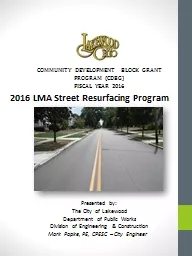PPT-Roadway Designer Resurfacing Restoration and Rehabilitation
Author : olivia-moreira | Published Date : 2019-02-09
Kevin Jackson Technical Director TLI Bentley Systems Inc Roadway Designer Overlay Tools Objectives Overlay Components Overlay Tools Overlay Stripping Components
Presentation Embed Code
Download Presentation
Download Presentation The PPT/PDF document "Roadway Designer Resurfacing Restoratio..." is the property of its rightful owner. Permission is granted to download and print the materials on this website for personal, non-commercial use only, and to display it on your personal computer provided you do not modify the materials and that you retain all copyright notices contained in the materials. By downloading content from our website, you accept the terms of this agreement.
Roadway Designer Resurfacing Restoration and Rehabilitation: Transcript
Download Rules Of Document
"Roadway Designer Resurfacing Restoration and Rehabilitation"The content belongs to its owner. You may download and print it for personal use, without modification, and keep all copyright notices. By downloading, you agree to these terms.
Related Documents














